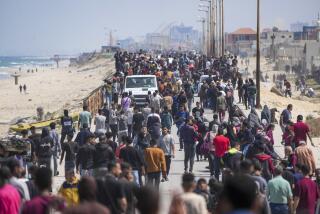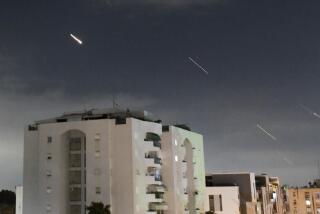Who gave N. Korea those power tools?
It has been so long since the sound has been heard in the North Korean capital that at first it seems an illusion, a buzzing in the ear perhaps. But no, that really is a power saw, and that pounding really is a hammer at work at a construction site.
By the dizzying standards of Asia’s exploding mega-cities, the construction here is nothing you could call a real estate boom. But it is a remarkable -- and somewhat mysterious -- development in a city that looks like it was frozen in time, with its Stalinist slabs of concrete from the 1950s and ‘60s.
Except for the monuments glorifying leader Kim Jong Il and his father, Kim Il Sung, the founder of North Korea, hardly anything new has gone up in decades. By night, the city is so quiet you can hear a baby crying from far across the Taedong River, which cuts through the center of town.
Yet these days, high-rise apartments in shades of pink are taking shape near the Pueblo, the American spy ship captured in 1968 and still anchored in the river. A tangle of construction cranes juts into the skyline near Pothong Gate, a re-creation of the old city wall. About 100,000 units are to be built over the next four years.
A modernistic silver-sided box of a conference center is already complete. Theaters and hotels are being renovated. Streets have been repaved and buildings repainted.
Even North Korea’s most notorious clunker, an unfinished 105-story hotel that looms vacant over the city, is under construction again after sitting idle for nearly two decades.
All are slated for completion by 2012, the 100th anniversary of the birth of Kim Il Sung. The deadline appears to have taken on new urgency for the appearance-conscious North Koreans, who fret that their capital has become a laughingstock.
“We know we need to modernize. We want to make the city comfortable for the people who live here and for tourists,” said Choe Jong Hun, an official with the Committee for Cultural Relations With Foreign Countries.
--
Economic free fall
What is mysterious is that North Korea appears to be as broke as ever. The country’s economy went into a free fall in the early 1990s with the collapse of the Soviet Union and other communist allies, and it has barely recovered. The United Nations’ World Food Program is warning that the country could be careening toward a famine similar to that of the mid-1990s, in which as many as 2 million people died.
North Korean officials insist that they’re funding the building spree on their own, in keeping with an underlying ideology that emphasizes self-reliance.
“If we rely on others, our dreams won’t be realized by 2012. It is all built with our own technology, our own material, our own labor, our own strength,” Choe said.
But analysts are skeptical of such claims, given the nation’s economy and the regime’s secretive nature and often deceptive pronouncements.
“This is a puzzle,” said Yoon Deok-ryong, a South Korean economist who recently visited Pyongyang. “The North Koreans are trying to show the outside world that they are not starving, that they are strong, but we know it is not true, so we wonder where the money is coming from.”
Many believe it’s trickling in from South Korea, China or the Middle East.
South Korea sharply cut its aid to the North this year after conservative President Lee Myung-bak took office and after a South Korean tourist was shot and killed at a North Korean resort for foreign visitors.
--
Is Kim chipping in?
But South Korean companies and individuals have mostly ignored the political chill. Among the biggest players here are a unit of the Hyundai conglomerate, which operates the resort where the shooting occurred, and companies affiliated with the Rev. Sun Myung Moon’s Unification Church, which also runs a car assembly plant in North Korea. The church last year completed work on what it calls the World Peace Center, behind the Potonggang Hotel, also owned by church affiliates.
A Chinese company, meanwhile, is renovating the No. 1 Department Store in the heart of downtown.
Expatriate businesspeople in Pyongyang say Kim might also be investing some of his own stash with an eye toward maintaining the loyalty of his Workers’ Party cadres. Apartments under construction look to be aimed at the elite.
The building spree began this summer during a wave of optimism that North Korea would shake its pariah status and join the international community after agreeing to end its nuclear weapons program.
“They wanted to make the city more presentable to the outside world. They thought that if the Democratic People’s Republic of Korea became a legitimate, well-accepted country, they could get more tourists,” said Pilju Kim Joo, a Korean American agronomist who works in North Korea much of the year.
The country has been hindered in its ability to raise money in international markets by its U.S. designation as a state sponsor of terrorism and by sanctions under the U.S. Trading With the Enemy Act.
President Bush in June promised to remove North Korea from the terrorism list because of steps it had taken toward denuclearization, but that move has stalled over concerns that Pyongyang did not submit an adequate inventory of its nuclear facilities.
--
Tall, dark and empty
Still, the building boom continues, much of it geared to tourists, whom the xenophobic regime historically has allowed to visit only in small numbers.
The Taedonggang Hotel, where Soviet dignitaries stayed in the 1960s and which burned down in 2002, is being restored as a five-star hotel. The Pyongyang Grand Theater, which stages revolutionary operas, is under renovation. The oldest and most elegant of the city’s movie theaters, the Taedongmun Cinema, was restored over the summer and used for screenings at the Pyongyang International Film Festival, which opened here last week.
The most visible project is the Ryugyong Hotel, an empty 105-story pyramid that was supposed to open in 1989, when it would have been the tallest hotel in the world.
“To be frank, we didn’t finish the hotel because we ran out of money,” said cultural relations official Choe. “Now we have the money coming in and we can go forward.”
Over the years, Japanese and South Korean companies have reportedly refused to take on the project because of concerns it was unstable or economically unfeasible. But the Egyptian conglomerate Orascom agreed to a face lift as part of a $400-million deal reached this year to install a cellphone network in North Korea.
Orascom’s resident project manager, Mahmoud Fawzi, said his company at the very least hoped to redo the facade to make it more attractive.
If the Ryugyong is salvaged, it would give Pyongyang a big psychological boost. For years, North Korean guides have pretended the hotel wasn’t there, refusing to answer the inevitable question from first-time visitors, “What’s THAT?”
North Korea is so embarrassed by the structure that it frequently airbrushes it out of official photographs. Now people are again showing a glimmer of pride in the building.
One confident tour guide, Oh Keum Suk, predicted: “Come back to Pyongyang in 2012 and you can stay in a room at the top.”
--
Demick was recently on assignment in Pyongyang.
More to Read
Start your day right
Sign up for Essential California for news, features and recommendations from the L.A. Times and beyond in your inbox six days a week.
You may occasionally receive promotional content from the Los Angeles Times.






